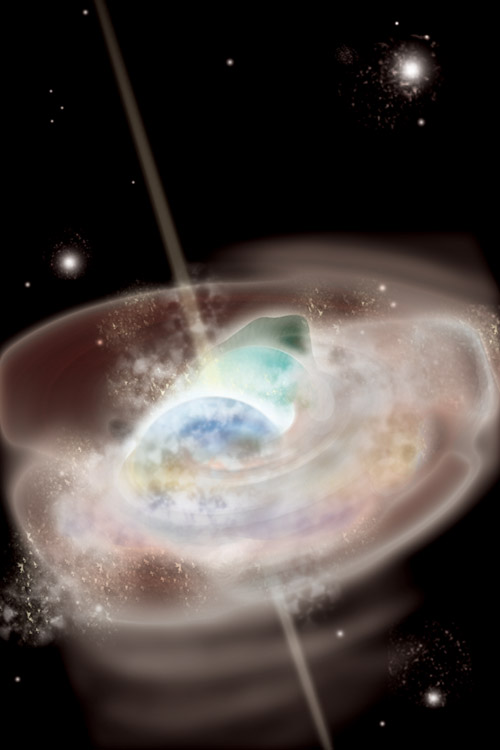Giant Space Blasts a Two-step Process

Scientists have taken another step closer toexplaining mysterious gamma ray bursts, some of the most energetic and brightexplosions in the sky.
Gamma ray bursts (GRBs)- the harbingers of death for some massive stars - are intense blasts of energyand radiation that eject from massive dying stars.
Now, scientists at the Istituto Nazionale di Astrofisica (INAF) in Italy have used NASA's Swiftsatellite - specially designed to automatically detect GRBs- to determine that GRBs are a two-step explosion.
"The first burst of energy, lasting lessthan a few minutes, is produced by shockwaves within the collapsing star,"study author Sergio Campana told SPACE.com in an email. "Whereas the longer, less energeticafterglow is produced by collisions between ejected matter and the materialaround the star, witnessing the X-ray light curves in the transition period fromprompt emission to afterglow."
This research isdetailed in the Aug. 18 issue of the journal Nature.
The soft X-rayafterglow following the initial GRB can last for periods ranging from hours toweeks. This afterglow was initially thought to be the slow fading of theinitial burst.
But after closelyobserving five GRBs and measuring the patterns ofX-ray emission, the INAF scientists determined that the afterglow was insteadcaused by violent shock interactions caused by the initial high-intensity blast.
Breaking space news, the latest updates on rocket launches, skywatching events and more!
"The duration of GRBs, together with their spectral properties, suggest aclassification into short and long bursts," Clemson University physicist DieterHartmann wrote in an accompanying 'News and Views' piece to the Nature article.
Short GRBs are believed to be caused by the merging of compactbinary stars, such as two neutron stars. However, scientists are not yetpositive this explanation is definite and plan to continue to use the Swiftsatellite to investigate the nature of these bursts.
When explaininglong GRBs, scientists favor the "collapsar"model. In this model, a rapidly rotating massive star has undergone extremegravitational collapse and created a black hole. A disk of material from thecollapsed star forms around the outer rim of the black hole. Through complexprocesses, a jet of high-energy radiation shoots from this disk, burstingthrough the surface of the star at almost the speed of light.
Intense bursts ofhigh-frequency gamma ray and X-ray radiation from exploding stars werediscovered nearly four decades ago. Since NASA launched the Swift satellite inNov. 2004, its detectors have picked up a burst every couple of days.
The Swift satelliteis the most autonomous spacecraft NASA has designed, using its three telescopesto detect and observe GRBs all on its own,automatically detecting the first stage of the explosion and targeting itselfon the event in about one minute.
